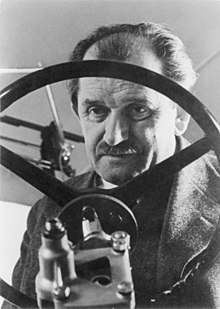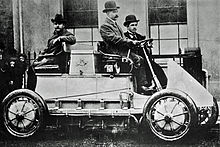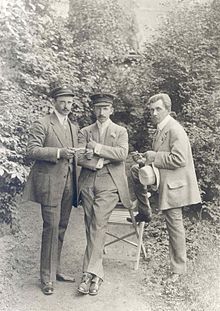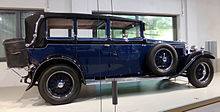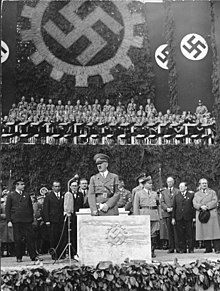Ferdinand Porsche
Ferdinand Porsche (born September 3, 1875 in Maffersdorf ( Bohemia ), † January 30, 1951 in Stuttgart ) was an Austrian , Czechoslovak and German automobile designer and founder of the Porsche company in Stuttgart.
Life
Childhood and family
Ferdinand Porsche was born as the third child of the plumber Anton Porsche. His extraordinary technical talent was evident early in his youth. He installed an electrical lighting system in his father's plumber. After elementary school , he began an apprenticeship in his father's plumbing company and attended evening classes at the Reichenberg State Trade School . Apart from theoretical lectures at what was then the Technical University of Vienna , which he attended without being enrolled, he did not attend a higher education institution. In 1903 Porsche married Aloisia Johanna Kaes from Purschau near Tachau . One year later, in 1904, their first child, daughter Louise , was born, and in 1909 their son Ferry was born .
First developments
In 1893, at the age of 18, Porsche joined the United Electricity AG Béla Egger in Vienna . There he rose from mechanic to head of the testing department in four years. During this time he designed the wheel hub electric motor , for which he applied for a patent in 1896. In 1899 he moved to the Lohner-Werke and built his first electric car there that same year, the following year the world's first vehicle with all-wheel drive, the Lohner-Porsche , and in 1902 the world's first hybrid vehicle . In 1904 he left the Lohner works.
Porsche at Austro-Daimler
Lohner made Porsche's research too costly. Therefore, in 1906, Porsche went to the Austrian Daimler-Motoren-Gesellschaft ( Austro-Daimler ) in Wiener Neustadt as development and production manager and successor to Paul Daimler . There he dealt with the development of passenger vehicles, aircraft engines and sports cars. His first aircraft engines for airships and airplanes appeared as early as 1908. In 1910 he and Heinrich Schönfeldt won the “ Prinz-Heinrich-Fahrt ”, a reliability test, with an Austro-Daimler designed by him, which he drove himself.
In World War I as a director of an arms factory indispensable, he constructed the Landwehr-Train (or electric train called). This was a petrol-electric powered tractor that pulled several automatically controlled trailers powered by wheel hub electric motors. In 1917 he was appointed General Director of Austro-Daimler. In 1917, Porsche was awarded an honorary doctorate from the Vienna University of Technology and the Officer's Cross of the Franz Joseph Order for its services to Austria . In 1918 he was proposed for elevation to the nobility; due to the end of the Habsburg monarchy , no decision was made.
After the war he built the two-seater sports car Sascha , which won the Targa Florio straight away in its class. By 1922, the racing cars had won 51 times in 52 starts. He voted for Czechoslovak citizenship, which he was able to do because of his place of residence, because it allowed him to take part in car shows and races abroad without hindrance. In 1923 he left Austro-Daimler after the Board of Management had severely cut the funds available for the racing car department.
Head of Design and Member of the Board of Management at Daimler
From April 1923 he worked in Stuttgart as head of the design office and member of the board of the Daimler-Motoren-Gesellschaft (DMG).
In the same year he had the architects Bonatz and Scholer build a villa at Feuerbacher Weg 48/50 in Stuttgart, which was expanded with a garage in the 1930s. Three prototypes of the “ KdF-Wagens ” ( VW Beetle ) were built there in 1935/36 . At DMG, he devoted himself to the further development of engine charging using mechanical superchargers ( compressor or Roots blower ). Building on this, he first designed the Mercedes 24/100/140 PS (later Mercedes-Benz Type 630) in 1924 and, from 1926, the well-known Mercedes-Benz Type S, SS and SSK sports car models in the new Daimler-Benz company . In recognition of the design of the two-liter supercharged Mercedes that won the Targa Florio , the Technical University of Stuttgart awarded Porsche the title of Dr.-Ing. honorary . His 1.3-l and 1.6-l models, on the other hand, proved to be complex to manufacture and prone to failure.
In 1926 the tense economic situation forced Daimler-Motoren-Gesellschaft and Benz & Cie. on the merger, which weakened Porsche's internal position in the new Daimler-Benz AG . His relaxed management style, the financial failures of the truck models and his larger financial liabilities to the company led to his employment contract not being renewed in 1928. Since Porsche assumed a lifelong position, a legal dispute arose. This ended in 1930 with a settlement . Porsche accepted the separation and Daimler-Benz decided not to pay Porsche’s debts.
Porsche left the position he took up as technical director of the Steyr-Werke at the beginning of 1929 in April 1930 because his position in the new interest group with Austro-Daimler was not tenable.
Foundation of the Dr. Ing. H. c. F. Porsche GmbH
Porsche therefore went into business for itself and opened a design office on December 1, 1930, which on April 25, 1931 was named “Dr. Ing. H. c. F. Porsche GmbH, Constructions and Consulting for Engines and Vehicles ”with its registered office at Kronenstrasse 24 in Stuttgart, was entered in the register for company companies. 80% of the company's shares were held by Porsche, 10% by the businessman and racing driver Adolf Rosenberger and 10% by his son-in-law, the Viennese lawyer Anton Piëch . He turned down an offer from the Soviet Union to become the first designer in 1932. In addition to his son Ferry Porsche , the team of technicians and engineers at the office included :
- Karl Rabe , chief engineer
- Karl Fröhlich , gear specialist
- Josef Kales , engine specialist and
- Josef Zahradnik , specialist in axle construction.
Later employees were:
- Erwin Komenda , automobile designer
- Josef Mickl , aerodynamics specialist
- Franz Xaver Reimspieß , engine engineer
Adolf Rosenberger made sure that, despite the lack of orders and Porsche's tendency towards expensive designs, the office survived the early days financially, but left the management on January 31, 1933. Baron Hans von Veyder-Malberg became the new commercial director and, with a ten percent stake, new shareholders. On July 30, 1935, Rosenberger ceded his ten percent shareholding in Porsche GmbH at nominal value to Ferry Porsche .
As one of the first orders in 1931 the design office developed a small car (Porsche Type 12) for Zündapp in Nuremberg. Note: The counting of Porsche developments began with the 7th, presumably in order to generate greater trust in the young company among clients.
The car was initially planned with a one-liter engine; the prototype had a water-cooled 1.2-liter 5-cylinder radial engine. Later, the mid-range Porsche Type 32 was designed for NSU , which already had a lot in common with the VW Beetle: The NSU Porsche also had an air-cooled four-cylinder boxer engine in the rear and the patented Porsche torsion bar suspension . However, due to the high production costs, these vehicles did not go into series production, making the orders less lucrative. The same was true for the construction of a two-liter touring car for hikers . From 1933 onwards, the development of the Grand Prix racing car, the Auto Union racing car , with a 16-cylinder mid-engine - known at the time as a rear engine - was very successful.
Development of the KdF car and construction of the Volkswagen factory
From 1934, Porsche and his office were commissioned by the Reich Association of the Automotive Industry to design the German Volkswagen, later also known as the KdF-Wagen or VW Beetle . The design of the Beetle is based on designs by Béla Barényi and Hans Ledwinka von Tatra , who were later awarded several patents. According to Adolf Hitler's specifications, the car should cost less than RM 1,000 . Due to the good earnings situation, Porsche changed the legal form of its engineering office to a limited partnership in 1937 . Veyder-Malberg was paid out. Partners were now his children Ferry with 15% and Louise with 5% and their husband Anton Piëch with 10%. In addition to the KdF car, Porsche was commissioned to develop a “people's tractor” in 1937 .
From 1938 Ferdinand Porsche was also general manager and member of the supervisory board of Volkswagenwerk GmbH , based in Berlin-Charlottenburg , which was supposed to produce the KdF car and which emerged from the "Society for the preparation of German Volkswagen mbH" (GeZuVor). In the years that followed, he was committed to establishing the Volkswagen factory near Fallersleben as the most modern automobile factory in Europe. The KdF car, which many people had saved up for, was never delivered, but the technology that Porsche had helped to develop was used in the Wehrmacht's Kübelwagen and swimming car.
He made his son-in-law, the Viennese lawyer Anton Piëch, his right-hand man as plant manager. In these functions, both ensured that the family's own design office in Stuttgart, which was practically the design department of the Volkswagen factory, always received lucrative orders. During the Second World War , he switched the Volkswagen factory over to the production of armaments, including the "retribution weapon" V1 . In 1943, on the initiative of the General Manager Porsche, the Volkswagen factory took over entrepreneurial responsibility at Peugeot in France.
Porsche's role in the Third Reich

In 1934, at Hitler's insistence, Ferdinand Porsche gave up his Czechoslovak citizenship and took on German. Porsche became a member of the NSDAP in 1937 (membership number 5,643,287). In 1938, together with Ernst Heinkel , Willy Messerschmitt and Fritz Todt, he was awarded the German National Prize for Art and Science , newly founded by Hitler in 1937 . In 1938 he received the honorary ribbon of the Bruna Sudetia Vienna fraternity , of which his son-in-law Anton Piëch was a member. He had also advocated the “Anschluss” of Austria . In 1940 Porsche was appointed honorary professor at the Technical University of Stuttgart. As SS-Oberführer he was accepted into the General SS at the end of January 1942 , which did not prevent him from wearing civilian clothes on all occasions. In addition, he was awarded the War Merit Cross First Class in 1942 and the skull ring of the Reichsführer SS in March 1944 . At that time, however, the skull ring was no longer considered a high honor.
Porsche, appointed military economist in 1939 , was heavily involved in the war industry. In the same year he was awarded the Grashof Memorial Medal from the Association of German Engineers . From 1941 to 1943 he was appointed chairman of the tank commission - a top position in the war economy. He was later appointed to the Armaments Council. As Hitler's favorite engineer, he was involved in the development of the VI Tiger armored vehicle, among other things . In 1942 Ferdinand Porsche took over the patronage of the testing and testing department (Pruva), the "Kraftfahrtechnischen Lehranstalt der Waffen-SS" (KTL) in the SS barracks Vienna-Schönbrunn. The "Pruva" of the KTL Vienna operated a branch in the Volkswagen factory in the city of the KdF car near Fallersleben , which dealt with the further development of the floating Volkswagen type 166. The tank destroyer Ferdinand named after him was built on the chassis of Porsche's prototypes . The Ferdinand, which was only produced in small series, was too heavy for the petro-electric drive designed by Porsche, whose susceptibility to failure led to more copies being abandoned than destroyed in battle. Finally, he developed the extremely heavy Panzerkampfwagen VIII Maus , which did not get beyond the stage of two prototypes.

In order to achieve its goals, Porsche was always ready to use all means that the Nazi regime offered and to activate all personal contacts with Hitler and Himmler for the purpose of support. With great loyalty, not altruistically, he used his great skills for the war policy of the Nazi dictatorship.
In October 1941, Porsche was one of the first business leaders to personally request Soviet prisoners of war as slave labor from Reichsführer SS Heinrich Himmler for the further expansion of the plant as an armaments factory during the war . In 1942 he himself ordered concentration camp prisoners from Hitler to build a new light metal foundry at VW. Around 20,000 people - two thirds of all those who worked in the VW plant during World War II - were forced laborers from Poland, the Soviet Union, Italy, France, Belgium and the Netherlands as well as German "Wehrmacht prisoners" and prisoners at the Arbeitsdorf concentration camp . The latter existed in Wolfsburg from 1942 to 1945. According to incomplete lists, around 500 prisoners of war, displaced persons and concentration camp inmates were killed in Wolfsburg. In Rüsten , near the VW works, the management, including Porsche, had a “ foreign children foster home ” built for the children of the forced laborers - as Fritz Sauckel, as general manager, had ordered. Hundreds of children died, hardly any survived. The SS doctor Hans Körbel , who was accused as a war criminal and executed on March 7, 1947 in the Hameln penitentiary , said in his trial that he had informed Porsche about the situation in the "home" at a directors' conference at the end of 1944. As far as is known, Porsche did nothing. “In February 1945, Porsche had concentration camp victims brought in from Buchenwald . They were supposed to expand the tunnels in Eschershausen near Holzminden in which he wanted to relocate his armaments production ” , writes the Frankfurt historian Ursula Krause-Schmitt. Mommsen writes about this period: "Ferdinand Porsche was last in the town of the KdF-Wagen on January 11, 1945 and obviously withdrew to Austria, where he saw the end of the war on the bulk goods in Zell am See."
After the Second World War
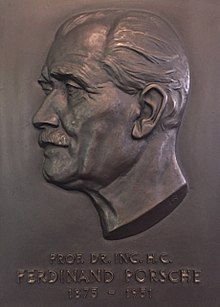
At the end of the Second World War , Porsche stayed in Gmünd and Zell am See in Austria , where he had already retired in January 1945 and where his children Louise and Ferry and the design office that had been relocated in 1944 were also located. At the instigation of the French Justice Minister Pierre-Henri Teitgen , he was arrested in Baden-Baden in December 1945 after an invitation from the French Industry Minister Marcel Paul, together with Ferry Porsche and Anton Piëch . They were accused of having arranged the deportation of French workers to Fallersleben and the deportation of directors of the Peugeot company to a concentration camp during the occupation of France . In addition, they were made responsible for the dismantling and relocation of machines and tools from the Peugeot company to the Volkswagen factory. Ferry Porsche was released after three months, Ferdinand Porsche and Anton Piëch spent 22 months in French prisons. They were released in August 1947 after paying bail. Thanks to a large number of testimonies, Porsche was able to obtain an acquittal in an ordinary French court in 1948, as it was not given any responsibility for the offenses and crimes alleged. His application for Austrian citizenship was rejected because it was forbidden for people naturalized into the German Reich until 1956 because of the National Socialist Act for 1933 to 1938.
On June 10, 1949, Porsche completed its registration form for the denazification procedure . After his proceedings before the Central Arbitration Chamber North-Württemberg were discontinued on August 30, 1949, which meant that he did not have to pay procedural costs of around DM 37,000, Porsche returned to Stuttgart from Austria.
In September 1948, Ferry Porsche signed a first contract with the Volkswagen plant under the direction of the new General Director Heinrich Nordhoff . The previously existing general contract for all VW development work replaced a case-by-case and freely negotiable order. In addition to the establishment of a non-competition clause for the use of Porsche's patents, a license fee of 0.1% of the gross list price was charged. B. 1950 for the standard version of a Beetle corresponded to an amount of 5 DM, agreed. In December 1949, a new agreement followed with a license fee of 1% of the gross sales price of the standard version. For the cooperation with VW in the further development of the VW Beetle, a monthly remuneration of 40,000 DM and the sole agency of Volkswagen in Austria were agreed. This formed a financial basis for the Stuttgart auto plant Dr. Ing.hc F. Porsche KG and the Austrian car trading company Porsche Holding .
Death and memory

Ferdinand Porsche died in Stuttgart in January 1951 at the age of 76. His grave is in Zell am See , where his urn is buried in the house chapel of the bulk material . The Porsche Museum in Stuttgart, the Porsche Automuseum Gmünd and an exhibition in the house where he was born in Vratislavice nad Nisou show his life's work . A museum belonging to his grandson Ernst Piech in Mattsee also commemorates him.
The entanglements of Porsche with the Nazi regime are judged differently. The Bochum historian Hans Mommsen , who led a research project on VW history on behalf of Volkswagen AG, described Porsche as a “ technocrat who was certainly not a war criminal ”. In contrast, critics and party members of the Greens in the Wolfsburg City Council in 1988 also attributed personal complicity to the suffering of forced laborers and concentration camp prisoners.
In 1977, in Vienna Liesing the Porsche street named after him. In 2010, after a commission report on the street names in Klagenfurt, Prof.-Porsche-Strasse was renamed Porschestrasse (after the car developed by Porsche).
In Wolfsburg, several buildings and a memorial commemorate Porsche. In 1951 - only a few hours after Porsche's death - the newly built main shopping street was named Porschestrasse . A secondary school that existed until 2014 was called Ferdinand-Porsche-Realschule, a stadium is called the Porsche-Stadion. A bronze bust of Ferdinand Porsche stands at the town hall .
The house where Ferdinand Porsche was born in Maffersdorf / Vratislavice nad Nisou (a district of Reichenberg / Liberec) was acquired by Škoda in 2011 and demolished in 2015, rebuilt and designed as a museum with an exhibition about Porsche. A plaque by the artist Ubbo Enninga from Stuttgart has been attached to the building since September 9, 2000.
Porsche's heirs
His son Ferry Porsche's company, the Dr. Ing.hc F. Porsche AG , is one of the most famous manufacturers of sports cars today . His daughter Louise Piëch (1904–1999) headed Porsche Holding GmbH , Salzburg, from 1952 to 1971 , which owns the sole agency rights of Volkswagen in Austria. His grandson Ferdinand Alexander Porsche designed the Porsche 911 , founded Porsche Design GmbH and was Chairman of the Supervisory Board of Porsche AG from 1990 to 1993. Wolfgang Porsche , the youngest son of Ferry Porsche, took over the chairmanship of the Porsche Supervisory Board in 2007. The grandson Ferdinand Piëch was Chairman of the Board of Management from 1993 to 2002 and then Chairman of the Supervisory Board of Volkswagen AG until 2015 .
Important developments
- Wheel hub motor (1897)
- Lohner-Porsche electric vehicle (1899)
- Torsion bar suspension (patent 1931)
- Mid-engine design in racing cars (1933)
- Transmission synchronization : Porsche synchronization (patent 1953)
literature
- Helge Dvorak: Biographical Lexicon of the German Burschenschaft. Volume I: Politicians. Volume 8: Supplement L – Z. Winter, Heidelberg 2014, ISBN 978-3-8253-6051-1 , pp. 159-161.
- Peter Müller: Ferdinand Porsche. The father of the Volkswagen. 4th, unchanged new edition, Stocker, Graz / Stuttgart 1998, ISBN 3-7020-0826-8 .
- Martin Pfundner: Austro Daimler and Steyr. Rivals until the merger. Ferdinand Porsche's early years. Böhlau, Vienna 2007, ISBN 978-3-205-77639-0 .
- Klaus Parr: Porsche, Ferdinand. In: New German Biography (NDB). Volume 20, Duncker & Humblot, Berlin 2001, ISBN 3-428-00201-6 , pp. 638-640 ( digitized version ).
- Ulrich Viehöver: Ferdinand Porsche. In: Hermann G. Abmayr (Ed.): Stuttgarter NS-Täter. From fellow travelers to mass murderers. Butterfly Verlag, Stuttgart 2009, ISBN 978-3-89657-136-6 , pp. 239-267.
- Porsche Museum , Stuttgart: Ferdinand Porsche - Pioneer of Hybrid Drives / Hybrid Automobile pioneer (German / English). Edition Porsche-Museum / DuMont, Cologne 2010, ISBN 978-3-8321-9322-5 or ISBN 978-3-9812816-4-4 .
- Wolfgang Graf: Austrian SS generals. Himmler's reliable vassals. Hermagoras-Verlag, Klagenfurt / Ljubljana / Vienna 2012, ISBN 978-3-7086-0578-4 , pp. 378–387.
- Hans Mommsen, Manfred Grieger: Ferdinand Porsche and the project planning of the German Volkswagen . In: The Volkswagen factory and its workers in the Third Reich. ECON Verlag, Düsseldorf 1996, ISBN 3-430-16785-X , pp. 71-91.
- Reinhard Osteroth: Ferdinand Porsche - the pioneer and his world. Rowohlt, Reinbek bei Hamburg 2004, ISBN 3-498-05036-2 .
- Karl Ludvigsen: Ferdinand Porsche - Genesis of Genius; Road, racing and aviation innovation 1900 to 1933. Delius Klasing, Bielefeld 2010, ISBN 978-3-7688-3188-8 .
- Gunter Haug : Ferdinand Porsche - a myth is born. 2nd Edition. Historical novel. Landhege-Verlag, Schwaigern 2015, ISBN 978-3-943066-04-3 .
Web links
- Literature by and about Ferdinand Porsche in the catalog of the German National Library
- Newspaper article about Ferdinand Porsche in the 20th century press kit of the ZBW - Leibniz Information Center for Economics .
- Biography Ferdinand Porsche
- Biography on www.stuttgart.de
- Porsche's imprisonment in Baden-Baden
- Entry about Ferdinand Porsche in the database of the Wilhelm Exner Medal Foundation .
- genealogy
- Ferdinand Porsche in conversation with Peter Kustermann, in the Witnesses of the Century series , created in the Nation's Memory project ( interview - September 7, 1986 - duration 59:57 minutes).
- Manfred Grieger: Ferdinand Porsche (1875-1951) , published on April 19, 2018 in: Stadtarchiv Stuttgart: Stadtlexikon Stuttgart.
Individual evidence
- ^ Wolfram Pyta , Nils Havemann and Jutta Braun: Porsche. From design office to global brand. Siedler, Munich 2017, ISBN 978-3-8275-0100-4 , p. 32.
- ^ Family tree of the Porsche family
- ↑ Porsche and not Toyota is the hybrid pioneer. In: FAZ . August 10, 2010, p. T4.
- ↑ a b c d Vienna's street names since 1860 as “Political Places of Remembrance” (PDF; 4.4 MB), p. 97ff, final research project report, Vienna, July 2013
- ↑ Arno Kerschbaumer, Nobilitierungen under the reign of Emperor Karl I / IV. Károly király (1916-1921) , Graz 2016, ISBN 978-3-9504153-1-5 , p. 184 lists under "Pending requests for a status survey and acts of grace": Application on elevation to the nobility for Dr.-Ing. Ferdinand Porsche, General Director of the Austrian Daimler-Motoren AG in Wiener Neustadt, application by the Austro-Hungarian Ministry of Commerce at the suggestion of the Austro-Hungarian Ministry of War, received by the Austro-Hungarian Ministry of the Interior on October 2, 1918, protocol number 22303, but no further decision was made.
- ↑ Ulrich Viehöver: The Porsche boss. Wendelin Wiedeking. With rough edges at the top. Campus Verlag, Frankfurt am Main 2006, ISBN 3-593-38125-7 , p. 70; and Ferdinand Piëch: Auto.Biographie. Hoffmann and Campe, Hamburg 2002, ISBN 3-455-09336-1 , p. 19.
- ^ Villa Ferdinand Porsche. In: arch INFORM ; accessed on December 14, 2009 ..
- ↑ Mommsen, Grieger: The Volkswagen factory and its workers in the Third Reich. 1996, p. 74.
- ^ Wolfram Pyta, Nils Havemann and Jutta Braun: Porsche. From design office to global brand. Siedler, Munich 2017, ISBN 978-3-8275-0100-4 , p. 37.
- ^ Wolfram Pyta, Nils Havemann and Jutta Braun: Porsche. From design office to global brand. Siedler, Munich 2017, ISBN 978-3-8275-0100-4 , p. 120.
- ^ Wolfram Pyta, Nils Havemann and Jutta Braun: Porsche. From design office to global brand. Siedler, Munich 2017, ISBN 978-3-8275-0100-4 , p. 122.
- ^ Wolfram Pyta, Nils Havemann and Jutta Braun: Porsche. From design office to global brand. Siedler, Munich 2017, ISBN 978-3-8275-0100-4 , p. 131.
- ↑ Bernd Wiersch: The Beetle Chronicle: The story of a car legend. 1st edition. Delius Klasing, Bielefeld 2005, ISBN 3-7688-1695-8 , p. 11.
- ↑ Mommsen, Grieger: The Volkswagen factory and its workers in the Third Reich. 1996, p. 75.
- ^ Siegfried Rauch, Reiner Scharfenberg, Günter Sengfelder: Zündapp 1922–1984 . Motorbuch-Verlag, Stuttgart 2006, ISBN 3-613-02684-8 .
- ↑ Béla Barényi was the spiritual father of the VW Beetle. In: Handelsblatt. March 1, 2007.
- ^ Béla Barényi . In: Der Spiegel . No. 24 , 1997 ( online - June 9, 1997 ).
- ↑ Mommsen, Grieger: The Volkswagen factory and its workers in the Third Reich. 1996, pp. 91, 939 and 940.
- ^ Wolfgang Graf: Austrian SS Generals. Himmler's reliable vassals. Klagenfurt / Ljubljana / Vienna 2012, p. 383.
- ↑ I agree with “Yes” In: Neue Freie Presse . April 9, 1938, p. 15.
- ^ Viehöver: Ferdinand Porsche. 2009, p. 243.
- ↑ Andreas Haka: Social networks in mechanical engineering at German university and non-university research institutions 1920–1970. Logos, Berlin 2014, ISBN 978-3-8325-3695-4 , pp. 150–155.
- ↑ Guido Knopp: Hitler's Manager. C. Bertelsmann, Munich 2004, ISBN 3-570-00701-4 and 3-570-00701-1 (wrong), p. 325.
- ↑ Witich Rossmann , Joachim Schmidt-Sasse: Prewar 1935-1939. Elefanten Press Verlag, Berlin 1989.
- ↑ Hans Mommsen, Manfred Grieger: The Volkswagen factory and its workers in the Third Reich. Econ Verlag, Düsseldorf 1996, pp. 939 and 940
- ^ Dieter Kolonovits, Hannelore Burger, Harald Wendelin (ed.): Citizenship and expulsion. Historians Commission of the Republic of Austria, Oldenbourg Wissenschaftsverlag, Munich 2004, ISBN 3-486-56692-X , p. 355.
- ^ Wolfram Pyta, Nils Havemann and Jutta Braun: Porsche. From design office to global brand. Siedler, Munich 2017, ISBN 978-3-8275-0100-4 , p. 310.
- ↑ Mommsen, Grieger: The Volkswagen factory and its workers in the Third Reich. 1996, p. 938.
- ↑ Mommsen, Grieger: The Volkswagen factory and its workers in the Third Reich. 1996, p. 939.
- ↑ Fahr (t) raum
- ↑ Katja Widmann: “A painting exhibition in this workers' town?” Art in the early years of Wolfsburg and Stalinstadt. dhm.de , accessed on August 23, 2018
- ↑ Former website of the school ( Memento of the original dated December 29, 2014 in the Internet Archive ) Info: The archive link was inserted automatically and has not yet been checked. Please check the original and archive link according to the instructions and then remove this notice. , accessed December 29, 2014
- ^ Czech Republic Online
- ↑ The Porsche exhibition at visitliberec.eu , accessed on March 2, 2017
| personal data | |
|---|---|
| SURNAME | Porsche, Ferdinand |
| SHORT DESCRIPTION | Austrian-German car designer |
| DATE OF BIRTH | September 3, 1875 |
| PLACE OF BIRTH | Maffersdorf near Reichenberg |
| DATE OF DEATH | January 30, 1951 |
| Place of death | Stuttgart |
